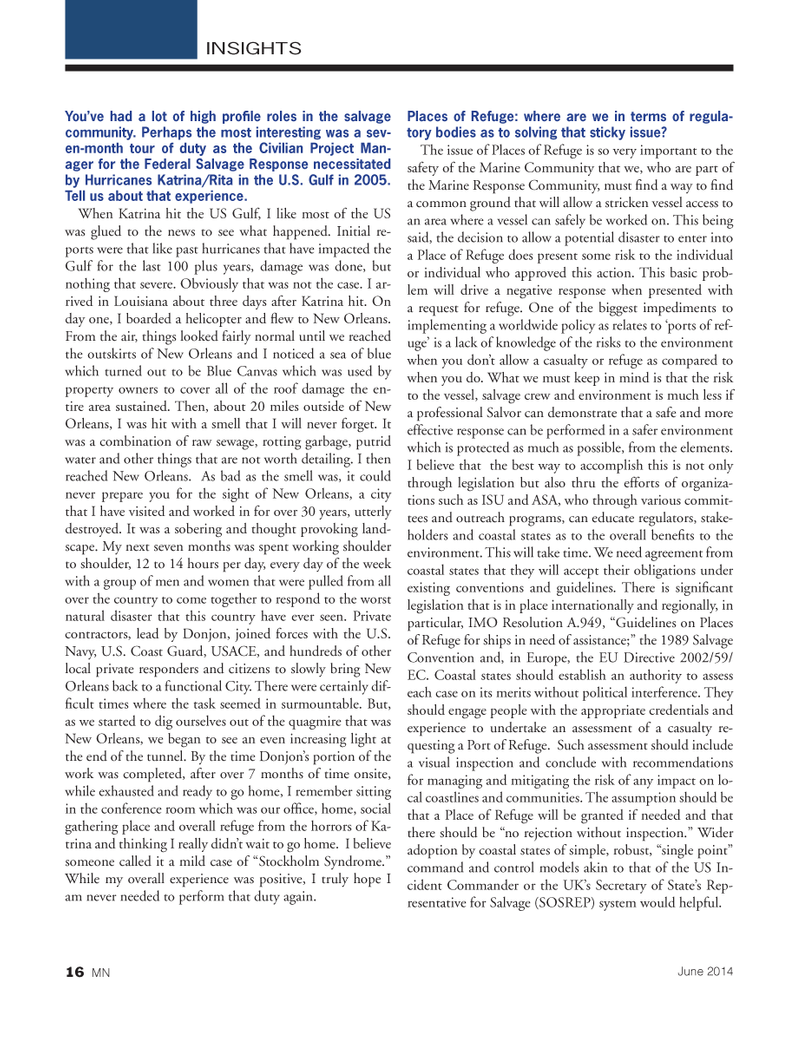
Page 16: of Marine News Magazine (June 2014)
Dredging & Marine Construction
Read this page in Pdf, Flash or Html5 edition of June 2014 Marine News Magazine
You?ve had a lot of high pro le roles in the salvage community. Perhaps the most interesting was a sev- en-month tour of duty as the Civilian Project Man- ager for the Federal Salvage Response necessitated by Hurricanes Katrina/Rita in the U.S. Gulf in 2005. Tell us about that experience. When Katrina hit the US Gulf, I like most of the US was glued to the news to see what happened. Initial re- ports were that like past hurricanes that have impacted the Gulf for the last 100 plus years, damage was done, but nothing that severe. Obviously that was not the case. I ar- rived in Louisiana about three days after Katrina hit. On day one, I boarded a helicopter and ß ew to New Orleans. From the air, things looked fairly normal until we reached the outskirts of New Orleans and I noticed a sea of blue which turned out to be Blue Canvas which was used by property owners to cover all of the roof damage the en- tire area sustained. Then, about 20 miles outside of New Orleans, I was hit with a smell that I will never forget. It was a combination of raw sewage, rotting garbage, putrid water and other things that are not worth detailing. I then reached New Orleans. As bad as the smell was, it could never prepare you for the sight of New Orleans, a city that I have visited and worked in for over 30 years, utterly destroyed. It was a sobering and thought provoking land- scape. My next seven months was spent working shoulder to shoulder, 12 to 14 hours per day, every day of the week with a group of men and women that were pulled from all over the country to come together to respond to the worst natural disaster that this country have ever seen. Private contractors, lead by Donjon, joined forces with the U.S. Navy, U.S. Coast Guard, USACE, and hundreds of other local private responders and citizens to slowly bring New Orleans back to a functional City. There were certainly dif- Þ cult times where the task seemed in surmountable. But, as we started to dig ourselves out of the quagmire that was New Orleans, we began to see an even increasing light at the end of the tunnel. By the time DonjonÕs portion of the work was completed, after over 7 months of time onsite, while exhausted and ready to go home, I remember sitting in the conference room which was our ofÞ ce, home, social gathering place and overall refuge from the horrors of Ka- trina and thinking I really didnÕt wait to go home. I believe someone called it a mild case of ÒStockholm Syndrome.Ó While my overall experience was positive, I truly hope I am never needed to perform that duty again. Places of Refuge: where are we in terms of regula- tory bodies as to solving that sticky issue?The issue of Places of Refuge is so very important to the safety of the Marine Community that we, who are part of the Marine Response Community, must Þ nd a way to Þ nd a common ground that will allow a stricken vessel access to an area where a vessel can safely be worked on. This being said, the decision to allow a potential disaster to enter into a Place of Refuge does present some risk to the individual or individual who approved this action. This basic prob- lem will drive a negative response when presented with a request for refuge. One of the biggest impediments to implementing a worldwide policy as relates to Ôports of ref- ugeÕ is a lack of knowledge of the risks to the environment when you donÕt allow a casualty or refuge as compared to when you do. What we must keep in mind is that the risk to the vessel, salvage crew and environment is much less if a professional Salvor can demonstrate that a safe and more effective response can be performed in a safer environment which is protected as much as possible, from the elements. I believe that the best way to accomplish this is not only through legislation but also thru the efforts of organiza- tions such as ISU and ASA, who through various commit- tees and outreach programs, can educate regulators, stake- holders and coastal states as to the overall beneÞ ts to the environment. This will take time. We need agreement from coastal states that they will accept their obligations under existing conventions and guidelines. There is signiÞ cant legislation that is in place internationally and regionally, in particular, IMO Resolution A.949, ÒGuidelines on Places of Refuge for ships in need of assistance;Ó the 1989 Salvage Convention and, in Europe, the EU Directive 2002/59/ EC. Coastal states should establish an authority to assess each case on its merits without political interference. They should engage people with the appropriate credentials and experience to undertake an assessment of a casualty re- questing a Port of Refuge. Such assessment should include a visual inspection and conclude with recommendations for managing and mitigating the risk of any impact on lo-cal coastlines and communities. The assumption should be that a Place of Refuge will be granted if needed and that there should be Òno rejection without inspection.Ó Wider adoption by coastal states of simple, robust, Òsingle pointÓ command and control models akin to that of the US In- cident Commander or the UKÕs Secretary of StateÕs Rep- resentative for Salvage (SOSREP) system would helpful. INSIGHTSJune 201416 MNMN June14 Layout 1-17.indd 16MN June14 Layout 1-17.indd 165/20/2014 11:58:32 AM5/20/2014 11:58:32 AM

 15
15

 17
17
